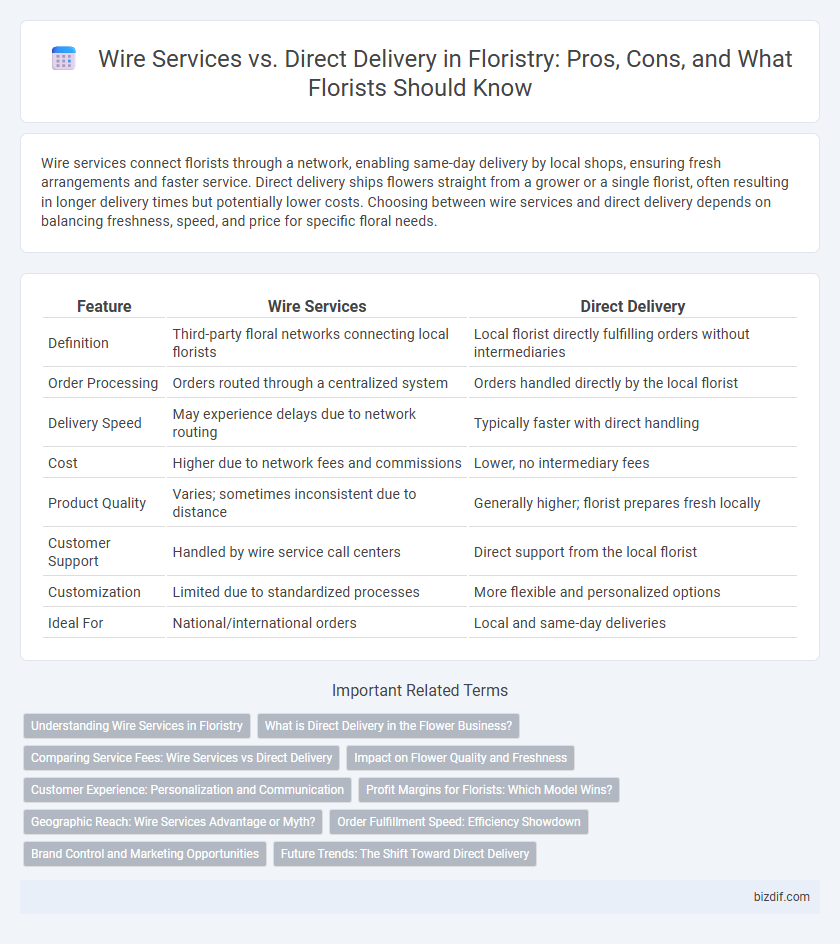Wire services connect florists through a network, enabling same-day delivery by local shops, ensuring fresh arrangements and faster service. Direct delivery ships flowers straight from a grower or a single florist, often resulting in longer delivery times but potentially lower costs. Choosing between wire services and direct delivery depends on balancing freshness, speed, and price for specific floral needs.
Table of Comparison
| Feature | Wire Services | Direct Delivery |
|---|---|---|
| Definition | Third-party floral networks connecting local florists | Local florist directly fulfilling orders without intermediaries |
| Order Processing | Orders routed through a centralized system | Orders handled directly by the local florist |
| Delivery Speed | May experience delays due to network routing | Typically faster with direct handling |
| Cost | Higher due to network fees and commissions | Lower, no intermediary fees |
| Product Quality | Varies; sometimes inconsistent due to distance | Generally higher; florist prepares fresh locally |
| Customer Support | Handled by wire service call centers | Direct support from the local florist |
| Customization | Limited due to standardized processes | More flexible and personalized options |
| Ideal For | National/international orders | Local and same-day deliveries |
Understanding Wire Services in Floristry
Wire services in floristry function as global networks that connect local flower shops with customers requesting deliveries outside their immediate area, facilitating orders through a centralized system. These services allow florists to transmit orders quickly and securely, ensuring timely delivery by local partners while maintaining quality standards and pricing transparency. Understanding wire services enhances consumer trust by enabling access to a vast floral inventory and seamless international or cross-city flower delivery options.
What is Direct Delivery in the Flower Business?
Direct delivery in the flower business refers to the process where a local florist arranges and delivers a floral order directly to the recipient without involving wire services. This method ensures fresher flowers, faster delivery times, and personalized arrangements tailored to specific customer requests. Local florists coordinating direct delivery maintain quality control and support local businesses, enhancing customer satisfaction and reducing reliance on third-party networks.
Comparing Service Fees: Wire Services vs Direct Delivery
Wire services in floristry often charge higher service fees due to intermediary costs involved in processing and relaying orders, which can increase the final price for customers. Direct delivery typically offers lower fees as orders are placed directly with local florists, eliminating extra charges associated with wire networks. This cost difference makes direct delivery a more economical option for buyers seeking floral arrangements without inflated service fees.
Impact on Flower Quality and Freshness
Wire services often subject flowers to extended transit times and multiple handling points, diminishing freshness and bloom vitality upon arrival. Direct delivery from local florists ensures shorter delivery windows, preserving optimal flower quality and enhancing customer satisfaction. Maintaining freshness directly correlates with the precision of logistics and the proximity of the florist to the recipient.
Customer Experience: Personalization and Communication
Wire services in floristry offer convenience by connecting customers with local florists globally, but direct delivery enhances customer experience through personalized orders and real-time communication. Direct delivery allows florists to tailor arrangements specifically to customer preferences and provide updates on order status, fostering trust and satisfaction. Personalized interactions and transparent communication contribute significantly to a memorable floral gifting experience, surpassing the limitations of standardized wire service transactions.
Profit Margins for Florists: Which Model Wins?
Wire services often charge higher fees and commissions, reducing profit margins for florists compared to direct delivery models that eliminate intermediary costs. Direct delivery enables florists to retain more revenue per order by handling fulfillment in-house or locally, optimizing pricing strategies and customer relationships. Evaluating transaction volumes and operational efficiencies is crucial for florists to determine which model maximizes profitability in their specific market.
Geographic Reach: Wire Services Advantage or Myth?
Wire services offer extensive geographic reach by connecting local florists across numerous regions, enabling same-day delivery virtually worldwide. However, this advantage sometimes results in higher costs and inconsistent quality due to third-party handling. Direct delivery bypasses intermediaries, providing fresher arrangements but often limited to local or regional areas, challenging the notion that wire services always guarantee superior geographic coverage.
Order Fulfillment Speed: Efficiency Showdown
Wire services in floristry streamline order transmission by connecting local florists globally, enabling quicker access to regional suppliers but adding steps that may delay fulfillment. Direct delivery bypasses intermediaries by sending orders straight to the source florist, often reducing processing time and enhancing order fulfillment speed. Evaluating order volume and geographic scope helps determine whether wire services or direct delivery maximizes efficiency in floral order completion.
Brand Control and Marketing Opportunities
Wire services in floristry offer extensive network reach but limit brand control due to standardized delivery processes, often diluting florist identity and marketing efforts. Direct delivery empowers florists to maintain full brand presence, enhancing customer loyalty through personalized packaging and messaging. Controlling marketing channels directly allows florists to collect valuable customer data, driving targeted promotions and stronger brand recognition.
Future Trends: The Shift Toward Direct Delivery
Wire services are rapidly adapting to the increasing demand for direct delivery as florists seek greater control over quality and customer experience. Future trends highlight a significant shift toward direct delivery models, leveraging advanced technology and local fulfillment to enhance freshness and reduce costs. This evolution aims to foster stronger relationships between florists and end customers, bypassing traditional intermediaries.
Wire Services vs Direct Delivery Infographic

 bizdif.com
bizdif.com